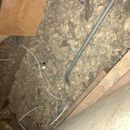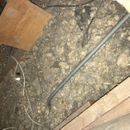Asbestos insulation?
Can anyone identify what type of insulation this is? This home was built in the 1950s and the previous owners did some renovations in the 1980s. Is this a type of insulation that could contain asbestos?
GBA Detail Library
A collection of one thousand construction details organized by climate and house part












Replies
Olderhouse,
Like your house, I was assembled in the 50's. At first glance, it appears to be mineral wool. The older mineral wool forms I saw were different in appearance from the current batt and board form seen today. It was available in the loose fill style, as well as two with paper; one fully encased like a long pillow, the other just the stud bay face like today. The paper encased type looked a bit more like tan cotton candy. The texture was relatively scratchy and looked coarse when pulled apart. It feels heavy compared to fiberglass. So much for idle past times in the attic. In our house the paper facing was black, so no the color isn't dangerous.
One test to see if it is mineral vs fiberglass insulation is to take a small bit outside and attempt to melt it with a blow torch. Fiberglass puffs will melt and collapse where the mineral wool puffs will stay relatively intact and glow red. Early fiberglass brands were not pink, so visual reference is not sufficient. Neither mineral wool or early fiberglass pose asbestos problems in of themselves.
Beware that the presence of asbestos can't be ruled out if vermiculite was ever in the house. If underneath the loose fill insulation you find the little brown nuggets, you will need to test that. It is essentially puffed mica bits. Not all vermiculite was contaminated, so don't panic just yet. If it proves to be, a good method of cleanup involves having it vacuumed out with special HEPA hazardous waste equipment. In some areas the service is easily found.
If you find dirty white-ish gravel-like material, that might be perlite, a pumice based product that is still around. I don't think asbestos has been associated with perlite, but I have never needed to address that question.
You will likely find mouse tunnels and collections of poop. The mice in our attic never seemed to be bothered by the mineral wool. The ones in my first grownup home greatly enjoyed the fiberglass. Hantavirus is a possible risk, so minimize stirring stuff up if you elect to remove the insulation. Having sucked up far too much attic dust over the years myself, I would suggest the same attic vacuuming services over do-it-yourself.
Deleted
The only real way to know if your insulation contains asbestos is the have a sample examined under a microscope most of the people with the skills and equipment want to be paid for their efforts.
Walta
And the test is not expensive, around $30 per sample.
Have it tested. Around here the initial test is a lot more, $125 for first sample, less for 2nd, 3rd etc. But whats the alternative, possibly putting yourself and others at risk of inhaling lots of asbestos dust?